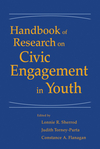 Today I received my copy of the Handbook of Research on Civic Engagement in Youth, edited by the star team of Lonnie R. Sherrod, Judith Torney-Purta, and Constance A. Flanagan. It provides 706 large pages–24 chapters by 53 authors–about how, why, and when young people participate in politics and civic life.
Today I received my copy of the Handbook of Research on Civic Engagement in Youth, edited by the star team of Lonnie R. Sherrod, Judith Torney-Purta, and Constance A. Flanagan. It provides 706 large pages–24 chapters by 53 authors–about how, why, and when young people participate in politics and civic life.
In 1985, Timothy Cook wrote an American Political Science Review piece entitled “The Bear Market in Political Socialization.” As he noted, the body of research on how people become citizens was then strikingly small, considering that the future of our democracy depends on that question. A few fine scholars wrote on this topic, but they were scattered among political science, developmental psychology, and education research, with little interdisciplinary dialogue and few inroads into other relevant disciplines, such as sociology and communications.
Further, the current scholarship had virtually no impact on practice. Educational policies, classroom strategies at all levels (from kindergarten to graduate school), community service programs, and the efforts of political campaigns and the news media to reach young audiences were some of the areas of practice that were conspicuously uninfluenced by theory or research about young people as citizens.
The new Handbook illustrates that we are now in a bull market, with scores of active scholars turning out heaps of research on youth civic engagement and interacting constantly with practitioners.
My own chapter, by the way–co-written with Ann Higgins-D’Alessandro–considers some of the crucial philosophical questions that arise when we ask how young people should be educated for citizenship. A not-so-hidden agenda is to persuade readers that education is not a matter for positivist social science alone. It is intrinsically about values; and good research is defined in part by having good values.